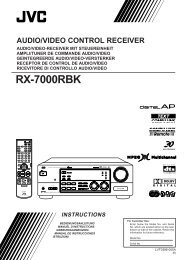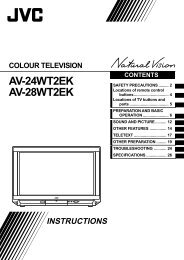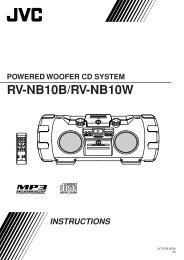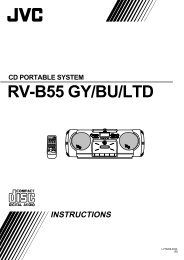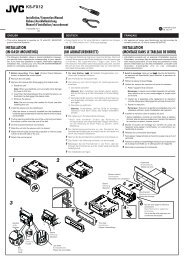GR-DVL9600 GR-DVL9500 - JVC
GR-DVL9600 GR-DVL9500 - JVC
GR-DVL9600 GR-DVL9500 - JVC
You also want an ePaper? Increase the reach of your titles
YUMPU automatically turns print PDFs into web optimized ePapers that Google loves.
T<br />
W<br />
To DV OUT<br />
DV cable<br />
(provided with<br />
<strong>GR</strong>-<strong>DVL9600</strong>,<br />
optional for<br />
<strong>GR</strong>-<strong>DVL9500</strong>)<br />
To DV IN<br />
Video unit equipped<br />
with DV connector<br />
RM-V711U<br />
(provided)<br />
PLAY (4)<br />
STOP (5)<br />
Lock Button<br />
PLAYOFF<br />
Power Switch<br />
5S<br />
Digital Dubbing<br />
EN53<br />
It is also possible to copy recorded scenes from the<br />
camcorder onto other video unit equipped with a DV<br />
connector. Since a digital signal is sent, there is little if any<br />
image or sound deterioration.<br />
1<br />
CONFIRM POWER-OFF STATUS<br />
Make sure the camcorder’s power is off.<br />
2<br />
MAKE CONNECTIONS<br />
Connect the camcorder to your video unit equipped<br />
with a DV connector using the DV cable as shown in<br />
the illustration.<br />
3<br />
START PLAYBACK<br />
Press PLAY (4) to play back the source tape.<br />
4<br />
START RECORDING<br />
While watching the playback on the monitor, engage<br />
the DV connector-equipped video unit’s record mode<br />
from the spot on the source tape you want to begin<br />
recording.<br />
NOTES:<br />
● It is recommended to use the AC Power Adapter/ Charger<br />
as the power supply instead of the battery pack ( pg. 7).<br />
● For Digital Dubbing, the <strong>GR</strong>-<strong>DVL9600</strong> or <strong>GR</strong>-<strong>DVL9500</strong> can<br />
be connected only to one device at a time. The<br />
<strong>GR</strong>-<strong>DVL9600</strong> can also be used as a recorder. When using<br />
the <strong>GR</strong>-<strong>DVL9500</strong> for dubbing, be sure to use it as a player.<br />
The <strong>GR</strong>-<strong>DVL9500</strong>’s DV connector is only for output.<br />
● If a blank portion is played back during dubbing, an unusual<br />
image may be dubbed.<br />
● Even though the DV cable is connected correctly, sometimes<br />
the image may not appear in step 3. If the above<br />
occurs, turn off power and make connections again. 1<br />
● If “Playback Zoom” ( pg. 56), “Playback Special Effects”<br />
( pg. 57) or “Snapshot” is attempted during playback,<br />
only the original playback image recorded on the tape is<br />
output from the DV OUT connector.<br />
● During Digital Dubbing, the scenes recorded in High Speed<br />
Recording mode are divided into 2, and the image is<br />
displayed both in the upper and lower halves of the screen<br />
( pg. 45).<br />
● Be sure to use a DV cable with the core filter.<br />
● Be sure to wind the DV cable twice around the core filter<br />
attached to the end connected to the camcorder.<br />
To Use This Camcorder As A Recorder (<strong>GR</strong>-<strong>DVL9600</strong> only) . . .<br />
1. Turn the Power Switch to “ ” while pressing down the Lock Button located on it.<br />
2. Connect the DV cable as shown in the illustration and load a cassette to record on.<br />
3. Press the Recording Start/Stop Button to engage the Record-Pause mode. “DV IN” appears on the screen.<br />
4. Press the Recording Start/Stop Button to start recording. “DV IN” changes to “ DV IN ”.<br />
5. Press the Recording Start/Stop Button again to engage the Record-Pause mode. “ DV IN ” returns to “DV IN”.<br />
NOTES:<br />
● During Digital Dubbing, the image is dubbed using the recording mode selected in the Recording Menu<br />
( pg. 10).<br />
● Digital Dubbing is performed in the sound mode recorded on the original tape, regardless of the current<br />
“SOUND MODE” setting ( pg. 30).



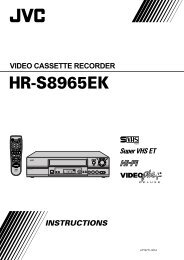
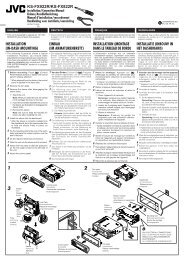

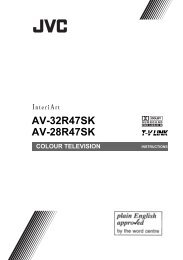
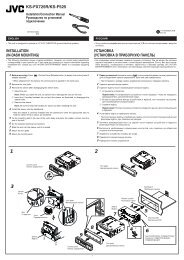
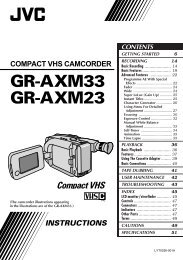
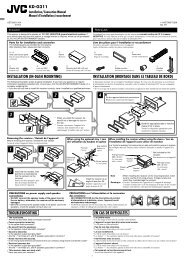

![TH-V70R[B] revision - JVC](https://img.yumpu.com/23738839/1/184x260/th-v70rb-revision-jvc.jpg?quality=85)
